Leaving your house to make money is so 2003. These days, you can make a pretty penny working from home, and selling digital products is a lucrative way to put your creativity to good use. But where can you sell your creations securely and at a nice profit? There are plenty of options, and no wonder.
Here's a fun statistic about digital products: The volume of such transactions has increased by nearly 70% in the last 2 years. It should, therefore, come as no surprise that the internet is flooded with platforms that let you sell these products without a website. Not all online marketplaces are equal, though.
If you're looking for a quick answer as to where you can sell digital products, Whop is a great way to do it. Getting started only takes a few minutes and joining Whop is entirely free.
However, if you're feeling more inquisitive and want to get a feel for all of the options out there, look no further.
We've compiled a comprehensive list of platforms where you can sell digital products for free. Check it out for our tried-and-tested top picks.
How to Sell Digital Products
Before we look at where you can sell digital products, lets look at how. Selling digital products is one of the easier ways to make passive income online. To begin with, all you really need is a product and a small amount of time to dedicate toward the upkeep of a sales platform—and there is no shortage of those.
Once you've picked a platform, you can sell:
- Trading tools
- Sports picks
- Crypto advice
- Fitness plans
- Access to paid communities
- Personal finance knowledge
- Ecommerce tips and tricks
- Podcasts
- Bots and extensions
- SaaS
- Courses
- One-on-one coaching
- Templates
- Plugins
- Access to live events
- Subscription services
- …and so much more.
Some marketplaces are specialized and are built around a specific type of product, such as Etsy, which is famously angled towards creatives like graphic designers, or Domestika, which is aimed at creatives sharing their craft. Others adopt a more general strategy, giving you more freedom.
Sell Digital Products for Free on These 10 Platforms
Selling digital products is still a relatively new way to make a living, but where there's demand, supply will always follow—so there are plenty of platforms to choose from. We've narrowed it down to 10 of the best ones that we've tested ourselves.
1. 🏅Whop
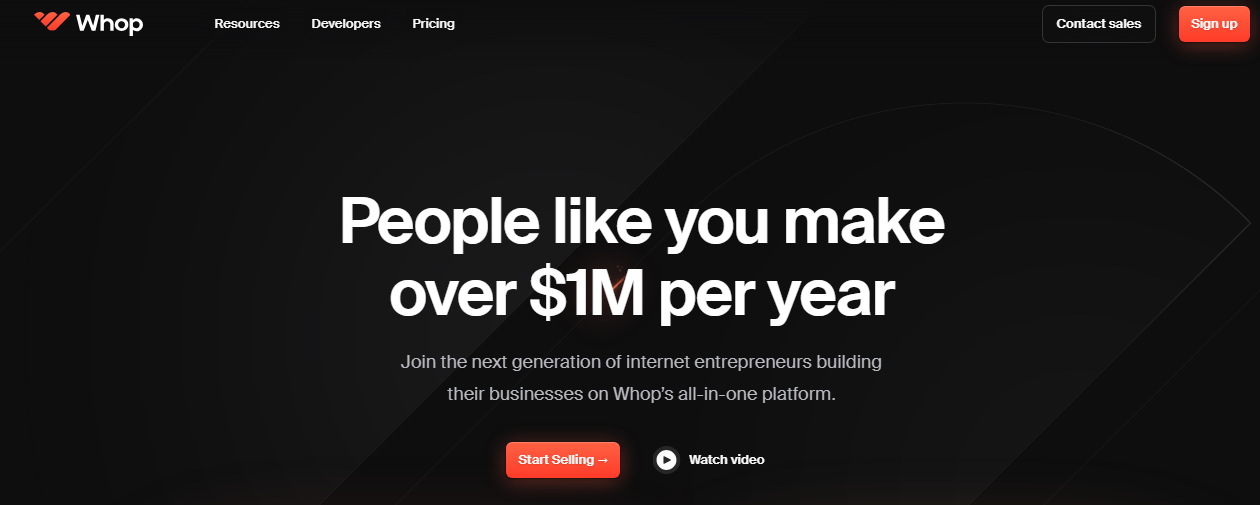
Whop is a social commerce platform where you can sell all sorts of digital products, ranging from courses to SaaS, to ebooks, to access to private communities, and more. The sales model supports both subscriptions and one-time payments, giving you maximum flexibility to match your pricing model to your products. Whop also offers easy automation features, such as sending out invites to Discord or Telegram communities or allowing people to book a call with you without the usual annoying back-and-forth we know from emails.
If you’re starting out as a seller online, what you want is a platform that will make things easy to figure out and not leave your head spinning. Whop excels at that thanks to its remarkably simple interface. Setting up your Whop Hub takes just a few minutes, and from there, you can add all sorts of apps, such as Chat, Discord access, Courses, Ebooks, and more, and then set up a pricing model that works for you.
If your goal is to break into areas of digital sales like finance, fitness, gaming, ecommerce, social media, dropshipping, cryptocurrency, and more, you'll love Whop. It's not just easy to use—it's flexible. You can integrate the Whop API seamlessly with your own website; send customers a link to your Hub, apply to sell on the Whop marketplace, or you can even just send your customers handy Checkout Links.
Pros
- No monthly fees/fixed costs
- Pay-as-you-go
- Secure checkout
- Intuitive navigation
- Integrated apps for ease of setup
Cons
- Not all features are available with PayPal payments
Percent of sales taken: 3% platform fee
2. Gumroad
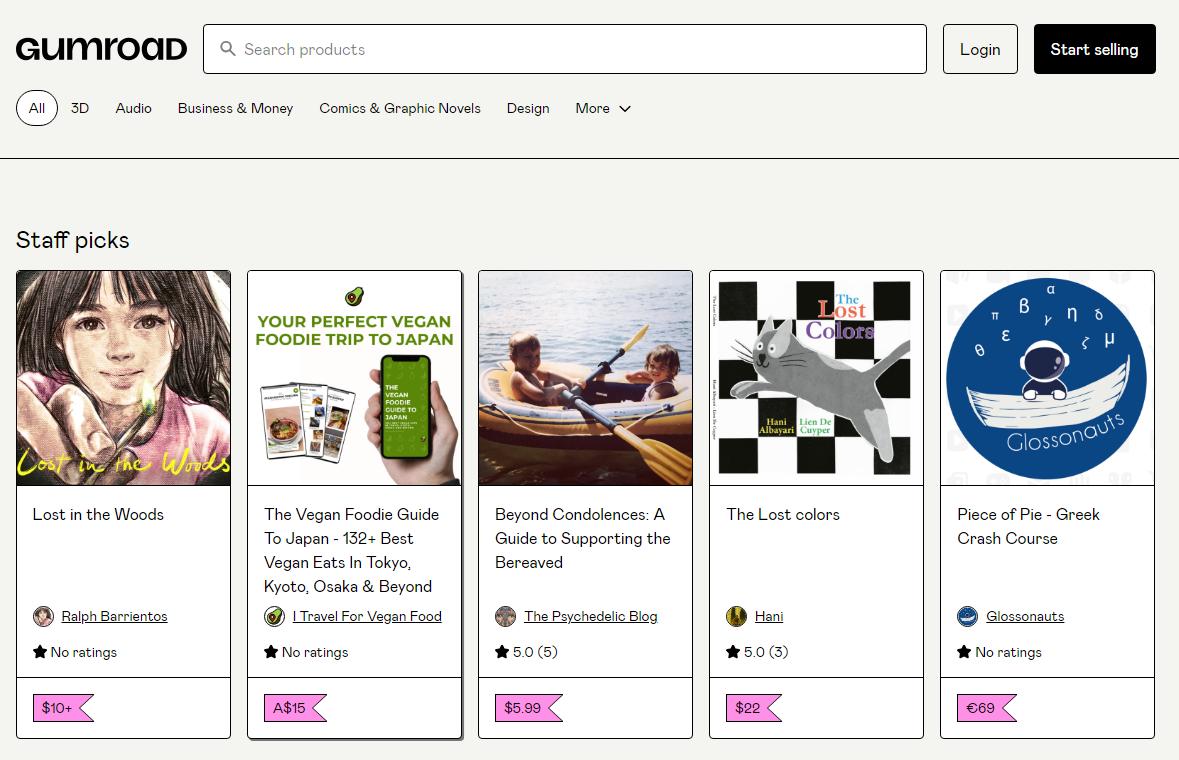
Gumroad has been around since 2012, which makes it one of the oldest online sales platforms on this list. Gumroad is a gateway platform for anyone who’s never tried to sell a product online before, and it's more focused on selling a single thing, such as an ebook, videos, software, design templates, or photos. There's a marked angle toward creativity as opposed to genres like ecommerce or finance.
The simplicity it offers can be a drawback to someone with more of a product range, though. What eases the intimidation factor for newbie sellers can turn into frustration for those who consider online sales old hat. The platform lacks the kind of expansive organization system that you might end up needing.
Gumroad also has a homemade touch kind of appeal that will work for some, but not others. It lacks the slick, polished vibe that some of its competitors are able to offer. However, it has a few interesting options, such as giving customers the ability to offer you a price for your product—something that most other platforms do not support.
Pros
- Auto-generated links can be added to your website
- Detailed sales statistics
- User-friendly interface
- Option to let customers offer a price for the product
Cons
- Not as easy to use if you offer several products
- Limited customization features
- Transaction fees on each sale are higher than many other platforms
Percent of sales taken: 10% flat fee + credit card/PayPal processing fees
3. Thinkific
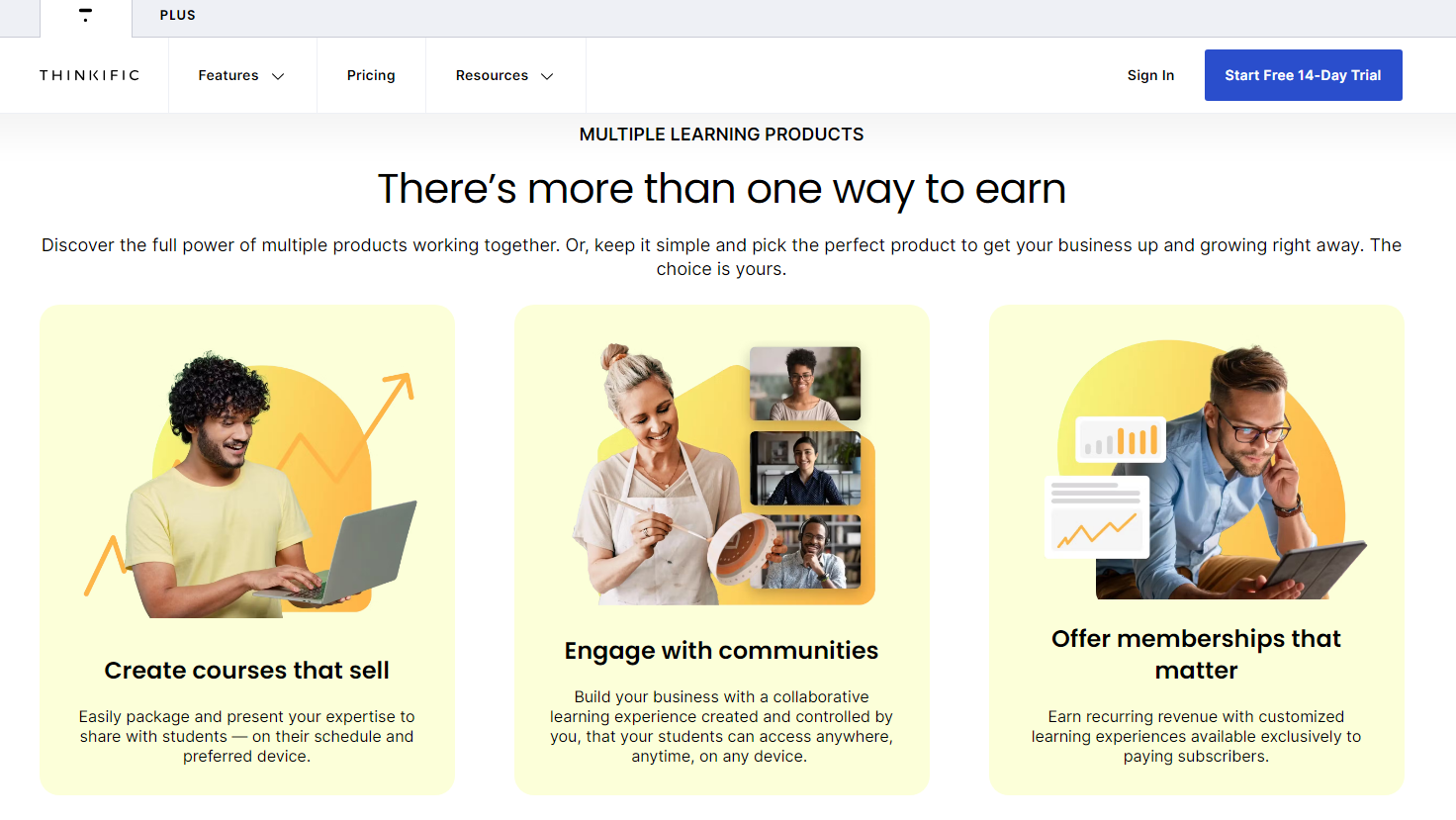
If the digital product you want to find your market for is some type of course or expert training, then Thinkific is worth a look. One of its benefits is that you don’t need to know any coding in order to get started—you can upload your course contents and have them online pretty quickly.
You can also incorporate more than just the course itself, just as long as it falls within the realm of e-learning. Thinkific has options for:
- Video
- Presentations
- Quizzes
- Worksheets
- Surveys
- Assignments
- Memberships
If you’re trying to sell a digital product that doesn’t come in the form of a course, then Thinkific may not be for you. Some of the additional course features may be limited or available only to paid users. The free Thinkific plan also includes their branding on your storefront, as well as a limitation on the number of courses that you can have, and students who can enroll in them.
Pros
- Comprehensive course creation tools
- Unlimited video hosting
- Easy-to-scale plans
Cons
- Limited range of customization options
- Lack of integration options
- Most useful features are paywalled
Percent of sales taken: various payment processing fees apply; additional paid plans unlock more features, which cost up to $150/month
4. itch.io
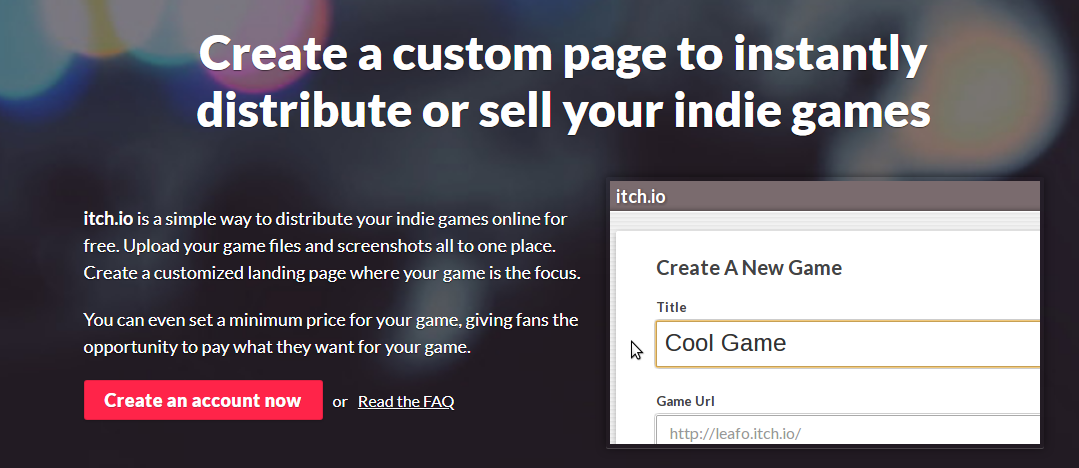
itch.io is great for game developers, musicians, comic artists, and writers who want to sell gaming content. You can use it to sell things like soundtracks, artworks for games, or even full games themselves.
The biggest competitor to itch.io within its own demographic is Steam, but Steam has much higher barriers to entry and only allows actual games. If you want to get some sales out of digital gaming content, itch.io is a much more accessible gateway into that world.
The pricing options on itch.io come in three tiers. You can choose the no payment option and have your files open to download for free, or you can take a donation of the buyer’s choosing, or, as a final alternative, you can set a minimum price that customers can still choose to pay above.
If you aren’t a gamer and you don’t think your content will appeal to gamers, you might want to keep exploring your options.
Pros
- No advertisements
- Open revenue sharing plan
- Flexible payout models
Cons
- Non-gamers may not find it suitable
- Non-customizable landing page
- Smaller market than gaming competitors
Percent of fees taken: 10% suggested
5. Payhip
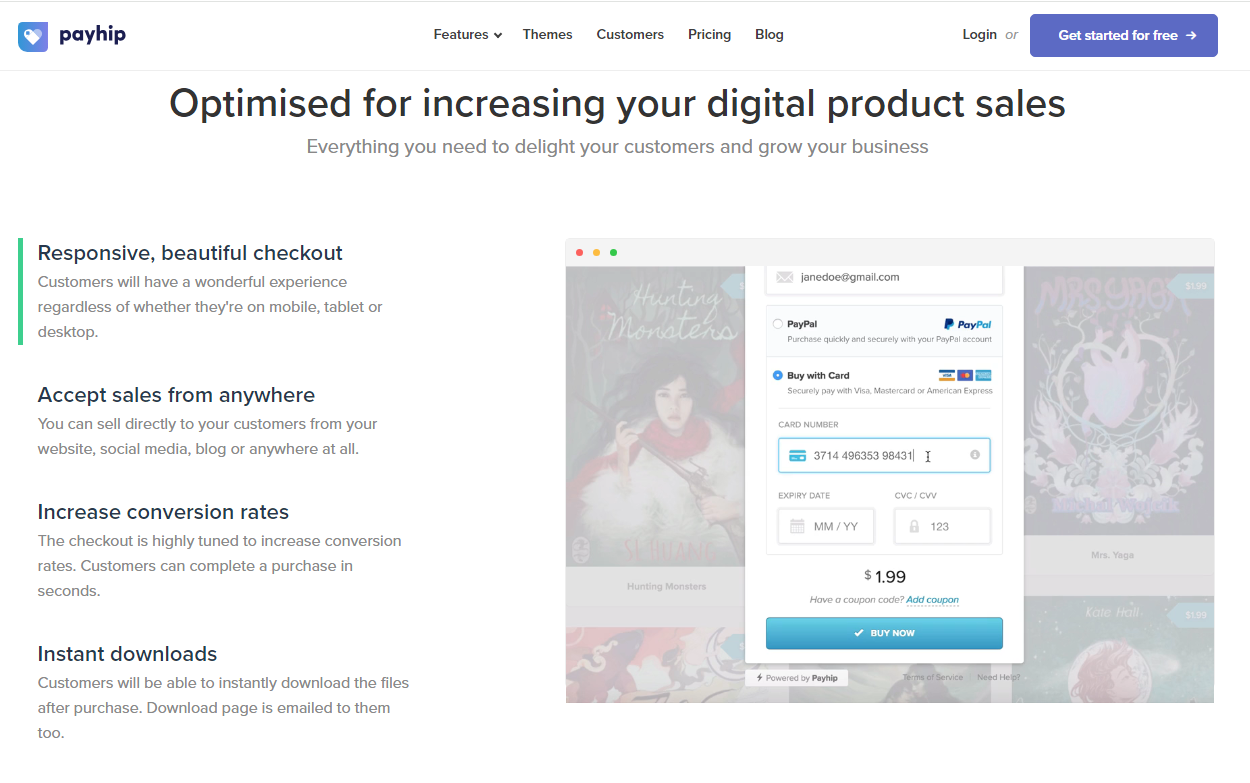
Payhip is a marketplace that advertises itself as open to all types of digital products. It gives you the option to list multiple items at a time, ranging from ebooks to music files and design templates, and you get an unlimited number of listings. Payhip's seller plans are somewhat unique because all of its 3 membership tiers offer the same features with no limitations.
For sellers concerned about the security of their products, Payhip offers specific features like PDF stamping and software licensing generation. This focus on security makes it easier for you to protect yourself against piracy—a common issue with certain types of digital products.
The biggest drawback with Payhip is the fact that you'll be paying a hefty transaction fee if you're on the free plan compared to the paid memberships. Therefore, the free plan is best if you don't want to pay an upfront fee and are happy to take a big cut out of each sale.
Pros
- Sales deposit immediately post-transaction
- No feature-gating between free and paid plans
- Shopping cart and checkout embeds directly on your website
Cons
- Limited payment options for buyers (PayPal or major cards)
- Limited SEO tools
Percent of fees taken: 5% transaction fee in the free plan; paid plans offer lower fees
6. Etsy

For artists and any other creatively inclined souls, there's one digital marketplace that is often seen as the go-to, and it's Etsy. It's a busy online marketplace, and that makes it a bit of a double-edged sword—on the one hand, you get a lot of eyes on your wares; on the other, the competition is huge.
Etsy lets you list a number of digital products, ranging from printables to planner pages and calendars. It's the go-to for fandom folk. Unfortunately, the downside of the platform is that it charges a lot more than many other similar websites, and with how saturated it is, sales are hard to come by. If you’re good at marketing yourself, Etsy sales can be lucrative—but it can be pretty hit and miss.
If you have a niche product, you may do fine on Etsy. Entering an established market may require an upfront investment to make sure that your shop appears higher in search results. Learning some SEO basics will also help you start selling on Etsy.
Pros
- Per-item listing fee can be cheaper if you have limited listings
- Customers are already familiar with how to purchase
- Increased potential customer base
Cons
- Not optimal if you have hundreds of products to list
- Recurring listing fees whether an item is selling or not
- Being high in results requires paid Etsy promotion or good SEO skills
Percent of sales taken: $15 one-time set-up fee; $0.20/item listing fee, 6.5% transaction fee
7. Teachable
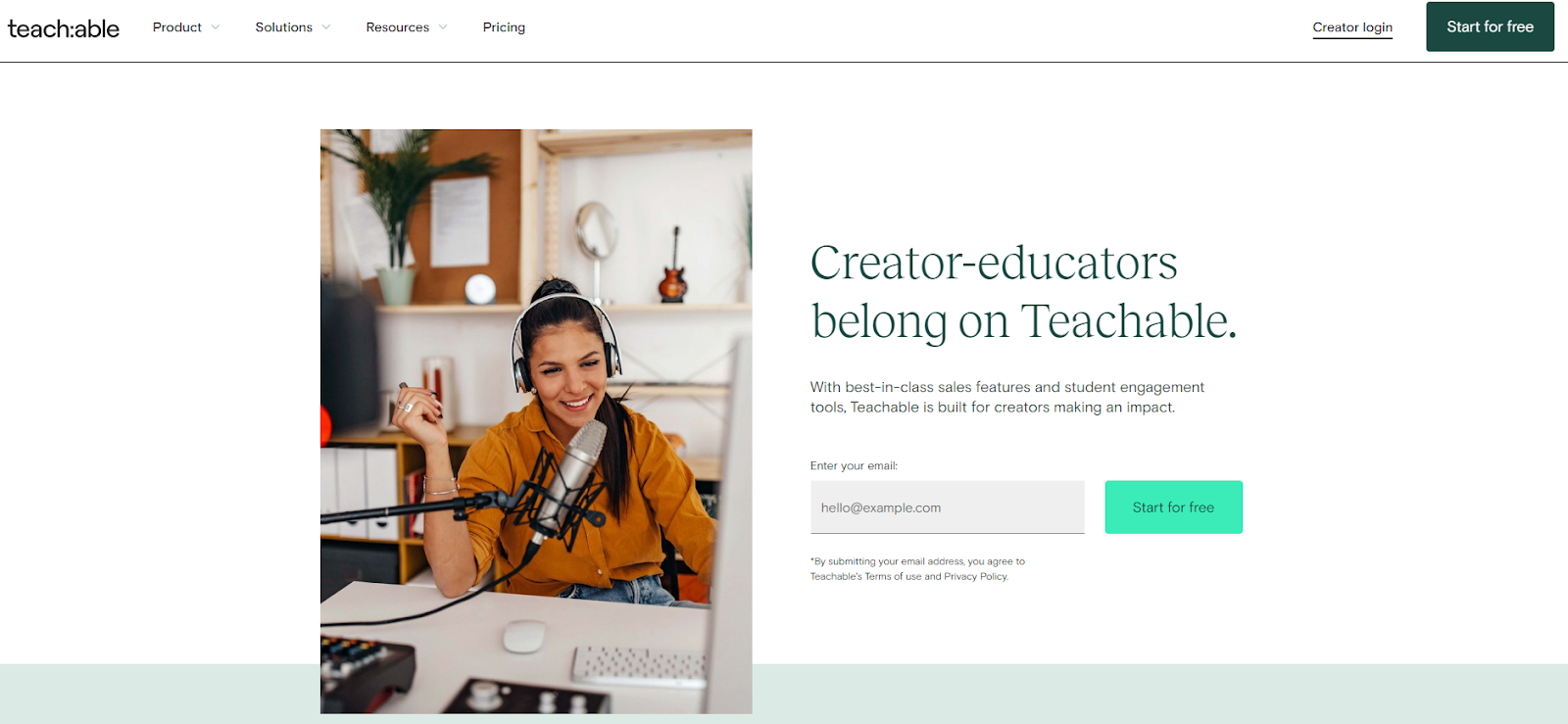
Teachable is a platform that specializes in digital sales for online courses, coaching, and downloadables. If you're an educator or a content creator in the e-learning niche, you may find it useful as an alternative to Thinkific.
If you want to sell more than just courses, it's possible to do with Teachable. You can also sell:
- Asset libraries
- Stock photography
- Email templates
- Lesson plans
- Spreadsheets
- Design files
- Music and audio
Teachable also offers the chance to expand via a knowledge base and Teachable U, which is its training resource for content creators.
Pros
- Integrated payment processing
- Offers certifications for completion
- Comprehensive analytics and reporting
Cons
- Limited student information available
- Quiz/assessment features only support multiple choice and true/false questions
Percent of sales taken: $1 + 10% transaction fee
8. Easy Digital Downloads
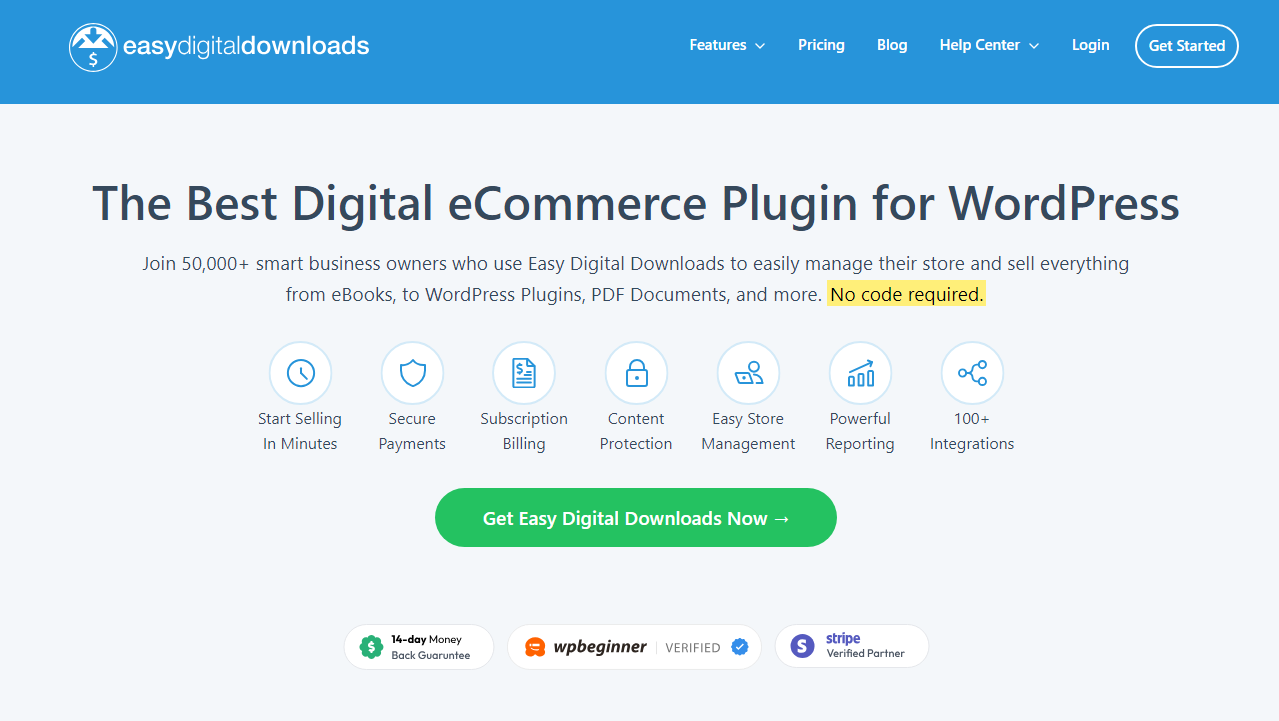
Instead of being a website-based platform like the others in this article, Easy Digital Downloads is a WordPress plugin. This might make it an immediate no-go for you if you aren’t familiar with WordPress or you're not planning to use it when you set up your work-from-home business.
If you’ve used WordPress in the past and are familiar with it, then installation and setup won’t be a roadblock! You’re a pro, you know what you’re doing.
This is a solid option if you just want something free of charge to get you started, but be warned that you might outgrow the core plugin. Much of the advanced functionality that most sellers want–like payment gateways, software licensing, and email marketing–come with extensions that you have to purchase separately.
Pros
- Easy to use if you know WordPress
- Offers extensions and integrations to enhance functionality
- Customizable checkout process boosts user experience
Cons
- Complex initial setup requires WordPress knowledge
- Only the core plugin is free
Percent of sales taken: No transaction fee or sales percentage
9. Podia
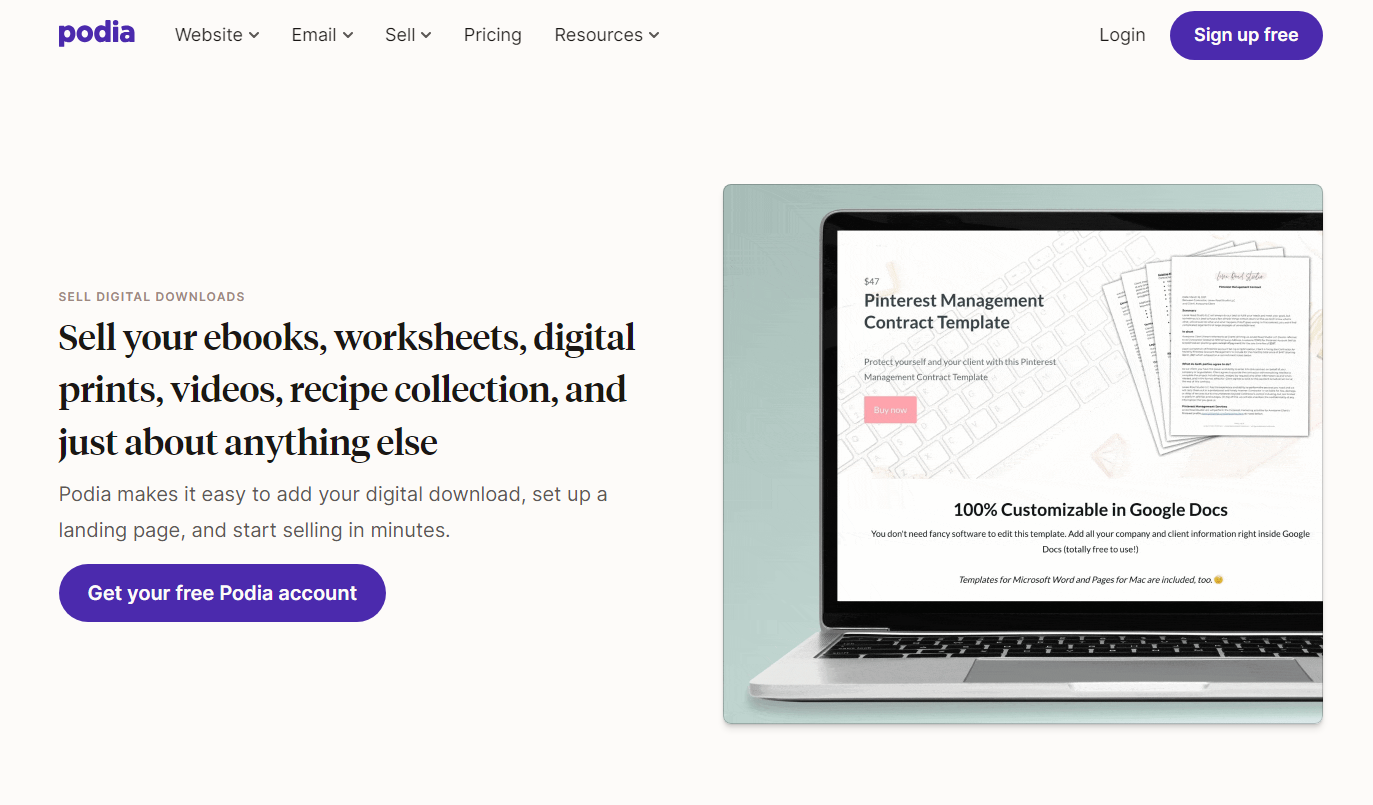
If your digital products are comprised of things like online courses, downloadables, or memberships, Podia is worthy of your consideration. It's a straightforward website that’ll serve the less technically inclined sellers well.
The free plan gives you your own storefront and blog, but limits you to one download and coaching product. If you want to start off on an ambitious note and sell multiple courses, you can’t do that on Podia under the free plan.
Podia does not currently have an app or any mobile version, so the courses are best viewed on a larger device. This may impact sales depending on the demographic of your customer base.
Pros
- No storage limits for digital content, making it video-friendly
- Interface allows for course creation, memberships, and community building
Cons
- Limited analytics on engagement and student progress
- Free plan limited to one download
- No mobile app option
Percent of sales taken: 10% transaction fee + payment processing fees in the free plan
10. Creative Market
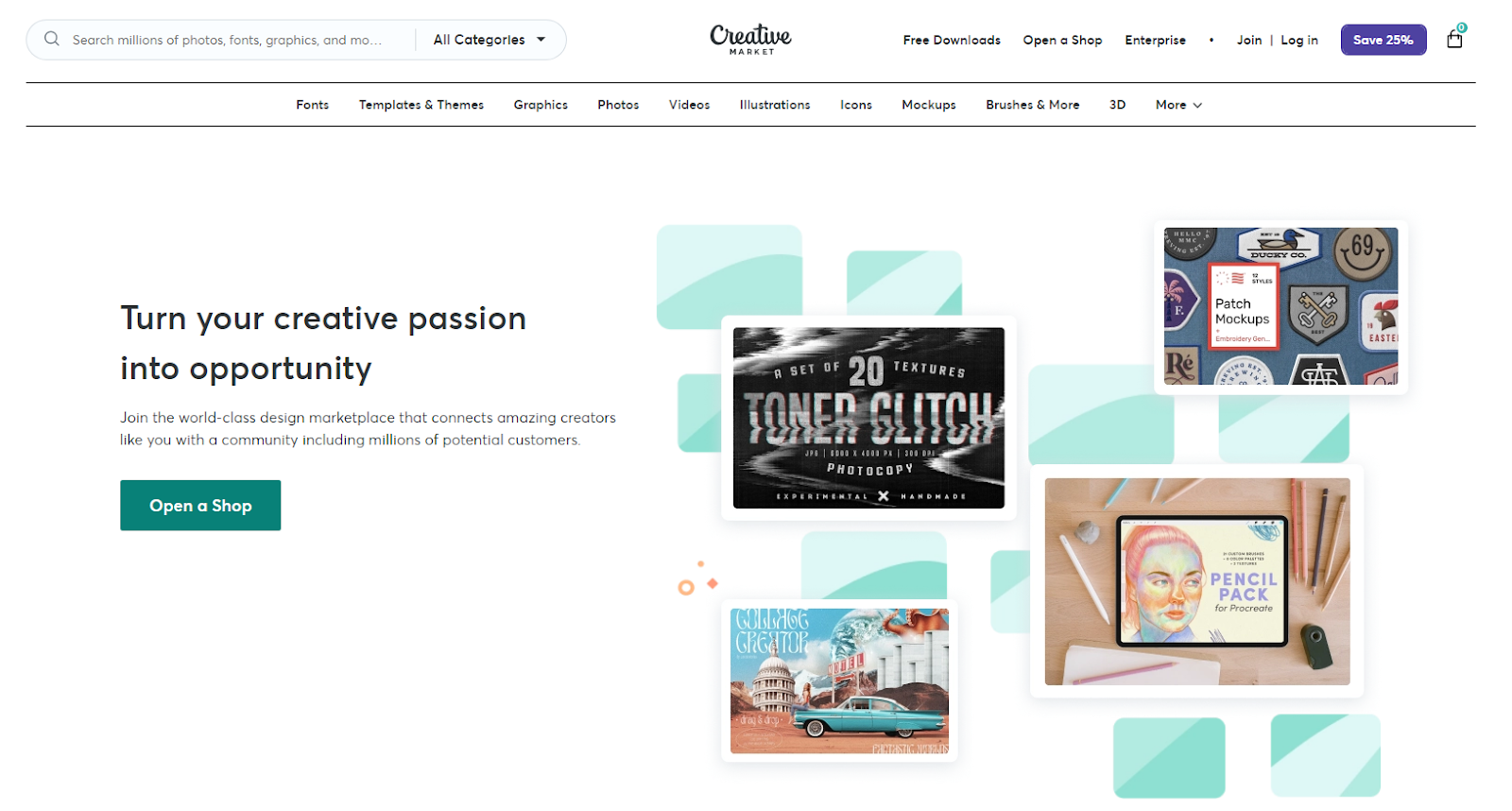
If you're a visual designer, Creative Market was made for people like you—but you still might be better off finding a home elsewhere due to its steep fees. You can sign up with Creative Market to sell any of the following:
- Fonts, templates, and themes
- Graphics, illustrations, photos, and videos
- Icons
- Mockups
- Brushes
- 3D Models
If you’re selling something heavily text-based or audio-centric (like an ebook or an audiobook) then you're better off trying a different platform. The demographic of sellers veers more toward graphic designers, web designers, and other creatives.
It may also not be for you if you want to keep more than half of the revenue from your sales. Creative Market has the highest commission rate of any website on this list. Ouch!
Pros
- Flexible licensing options (personal, commercial, and extended commercial)
- Regularly offers free resources for creators
- Affiliate system encourages buyers to promote you
Cons
- Eye-watering commission rate
- Payouts are monthly with no option for more frequent withdrawals
Percent of sales taken: 50% commission on all sales
Where is the Best Place to Sell Digital Products?
So, you've seen the full list of 10 of the best places to sell digital products. But how do you decide between them if none jumped out at you? It's simple: just think of yourself.
After all, making digital products takes time. You're putting your heart and soul into this gig, so it's important that the platform that you use to help you make money on it suits you and your exact needs. If you're a new seller, those needs might still be a bit of a mystery, so let's go over them one by one.
- Marketing
Pick a platform that suits your marketing needs. If you're fine keeping it low-key, then anything will do; if not, you need the full suite of marketing tools like affiliate marketing programs and email marketing campaigns, as well as the data analysis capabilities that come with it. - Scalability
You may be a seasoned ecommerce pro, or you may be a fresh seller looking to break into the market. In either case, look for a platform that can grow with you. For instance, a platform like Etsy that charges per listing, or a platform like Creative Market that takes a 50% cut out of each sale—those are fine if you only have a few products. If you want to scale up, they might devolve into a nightmare. - User experience—for you and for the customers
You don't want to spend hours poring over an unintuitive interface and trying to figure out what goes where, so click around on each platform and pick the one that feels easy to use. Then, do the same from the customer's POV. - Customer support
You're selling these things to make money. Look for a platform that has a responsive customer service team that you can reach out to at any step of the way. - Payment options
Platforms that offer limited payment options aren't ideal for customers, so they're also less-than-great for you. The more payment methods are supported, the better, and that doesn't just include things like PayPal or crypto, but also processing in multiple currencies. - Legal liability
Work with a platform that acts as MOR, meaning as the Merchant of Record. This is the entity that's legally responsible for processing transactions, collecting sales taxes, and handling chargebacks. - Payment plans
Being forced to charge a flat fee or a subscription is quite limiting. You're better off choosing a platform that lets you do either or both, such as Whop, where you can take one-time payments, monthly subscriptions, and even offer buy-now-pay-later instalments.
Although there are many ways to sell digital products, the platforms that tick all of the boxes mentioned above are few and far apart—but don't worry, Whop meets all of the criteria and more.
Sell Your Digital Products for Free with Whop!
It doesn't matter if you're a fitness guru, beauty influencer, sports capper or a crypto whiz. What matters is that you've got a business that's waiting to be monetized, and Whop is the best platform to team up with—for free!
Whop is a social commerce platform that lets you sell your digital products, ranging from sports betting picks to comprehensive courses on ecommerce and dropshipping, and everything in between. Whether you want to set up a paid community or let your customers book live calls with you, you can do this quickly and easily with a Whop Hub.
When you sign up, you'll be able to create your own Whop Hub and take your pick out of the many built-in apps that Whop offers. You can mix and match, such as by selling ebooks and courses at the same time, and all of this falls under the umbrella of your Hub. Next, you'll set up your pricing model, which can be a one-off fee or a subscription, and voila—you're all done, and you haven't had to pay a penny!
There aren’t many other platforms that give you the same exposure for no financial commitment and a competitively low sales percentage fee.
Getting your start as a Whop seller is as simple as making your free account. Create your products, set your prices, and wait for the money to start flowing in through Whop!
FAQs
What types of digital products can I sell?
The possibilities are almost endless. Here are some of the options:
- Online courses, lectures, seminars, and webinars
- Stock photography and video
- Digital art and graphics
- Ebooks and audiobooks
- Templates and themes
- Software, apps, and plugins
If you can think of it and create it digitally, there’s probably someone out there who wants to buy it!
What are the key features to look for in a digital sales platform?
What you should look for in a digital sales platform depends a lot on you, the seller—but in general, look for something that's transparent, trustworthy, and easy to use. It also depends on what you're selling. Whop is a good example of a platform that's free to start, only charges a low fee, and takes minutes to set up. Start selling with Whop today!
How do I choose the right digital sales platform?
To pick the right digital sales platform, you need to have an idea of where you see your online business going, and who your future customers are.
Once you’ve defined your goals and decided who it is you want to sell to, go through and compare the features of each platform. Compare your needs, match them up against the needs of your customer base, and weigh in which one works best for your unique situation.




